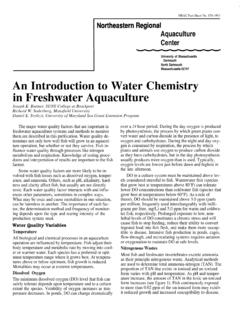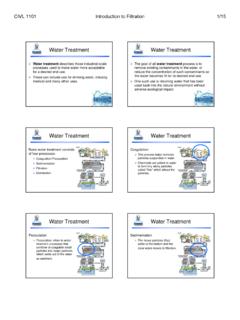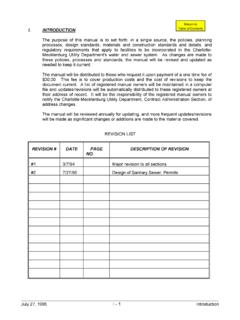Transcription of INTRODUCTION TO WASTEWATER TREATMENT
1 INTRODUCTION TO WASTEWATER TREATMENT INTRODUCTION .. 1 1 SOURCES .. 1 TREATMENT OBJECTIVES .. 2 water POLLUTION CONTROL LEGISLATION .. 2 WASTEWATER TREATMENT 3 DESCRIPTION OF PROCESS OPERATIONS .. 4 COLLECTION 4 PRELIMINARY TREATMENT .. 5 PRIMARY TREATMENT .. 5 ANAEROBIC 6 ACTIVATED 7 CHEMICAL 8 9 10 TERTIARY 10 DISCHARGE CRITERIA ..11 12 GLOSSARY OF TERMS ..12 INTRODUCTION TO WASTEWATER TREATMENT PAGE 1 OF 17 INTRODUCTION The following material will introduce the reader to the water pollution abatement and control measures practiced by the City of Guelph, Environmental Services Department, WASTEWATER Services Division.
2 HISTORY You may be surprised to learn that the TREATMENT of WASTEWATER is a relatively modern practice. Although sewers to remove foul-smelling water were common in ancient Rome, it was not until the 19th century that large cities began to understand the necessity of reducing the amount of pollutants in the used water they were discharging to the environment. Despite large supplies of fresh water and the natural ability of surface waters to cleanse themselves over time, populations had become so concentrated by 1850 that outbreaks of life-threatening diseases became commonplace.
3 These outbreaks were traced to pathogenic bacteria in the polluted water . What happens in a WASTEWATER TREATMENT plant is essentially the same as what occurs naturally in an ocean, lake, river or stream. The function of a WASTEWATER TREATMENT plant is to speed up this natural cleansing process. The practice of WASTEWATER collection and TREATMENT has been developed and perfected, using some of the most technically sound biological, physical, chemical and mechanical techniques available. As a result, public health and water quality are protected better today than ever before.
4 SOURCES WASTEWATER can be defined as the flow of used water discharged from homes, businesses, industries, commercial activities and institutions which is directed to TREATMENT plants by a carefully designed and engineered network of pipes. This WASTEWATER is further categorized and defined according to its sources of origin. The term domestic WASTEWATER refers to flows discharged principally from residential sources generated by such activities as food preparation, laundry, cleaning and personal hygiene.
5 Industrial/commercial WASTEWATER is flow generated and discharged from manufacturing and commercial activities such as printing, food and beverage processing and production to name a few. Institutional WASTEWATER characterizes WASTEWATER generated by large institutions such as hospitals and educational facilities. Typically 200 to 500 litres of WASTEWATER are generated for every person connected to the system each day. The amount of flow handled by a TREATMENT plant varies with the time of day and with the season of the year. INTRODUCTION TO WASTEWATER TREATMENT PAGE 2 OF 17 TREATMENT OBJECTIVES The overall water management objectives of WASTEWATER TREATMENT are associated with the removal of pollutants and the protection and preservation of our natural water resources.
6 Of specific concern is protection of human health by the destruction of pathogenic organisms present in WASTEWATER prior to treated effluent being discharged to receiving waters. water POLLUTION CONTROL LEGISLATION Environment Canada is the federal government agency responsible for environmental protection. Legislation in the form of the Environmental Protection Act provides overall direction for environmental protection in Canada. The Ontario Ministry of the Environment (MOE) is the provincial government agency responsible for environmental protection in the province of Ontario.
7 One of its tasks is the provision of clean water through pollution control and prevention. To accomplish its water quality objectives the MOE produced legislation in the form of the Ontario water Resources Act (OWRA). This legislation in conjunction with various regulations made under the OWRA set out legal requirements for managing environmental issues. The City of Guelph, Environmental Services Department, WASTEWATER Services Division (WSD), is engaged in WASTEWATER , storm water and water quality management for the area which it serves.
8 The WSD manages and operates the WASTEWATER TREATMENT Plant located at Hanlon and Wellington Street West and is responsible for meeting the TREATMENT standards prescribed by MOE legislation. Further to these requirements, the city has enacted legislation specific to its WASTEWATER operation passed by city council in the form of the Sewer Use By-law (1996)-15202. This By-law specifies the WASTEWATER quality and quantity standards which must be met by WASTEWATER generators who discharge to the city sewer collection and TREATMENT system.
9 INTRODUCTION TO WASTEWATER TREATMENT PAGE 3 OF 17 In addition to these pieces of legislation the MOE and the Municipal Engineers Associated of Ontario (MEAO) are jointly involved in developing additional legislation, namely, the Ontario Ministry of Environment Industrial Strategy for Abatement program (MISA). The program includes strategies for the development of analytical systems, adopting plans to address spills into systems, generation of an industrial inventory and an audit of enforcement activities. Certain WASTEWATER pollutants, primarily from industrial sources, have the potential to seriously disrupt the various WASTEWATER process operations and may present serious health risks to the public and employees associated with its TREATMENT .
10 The mandate of the MISA program is to eliminate and control such industrial WASTEWATER discharges at their source. WASTEWATER TREATMENT PROCESS By definition, process means a series of actions or changes. TREATMENT facilities incorporate numerous processes which in combination achieve the desired water quality objectives. These processes involve the separation, removal and disposal of pollutants present in the WASTEWATER . The TREATMENT of WASTEWATER is accomplished by four basic methods or techniques; physical, mechanical, biological and chemical.















